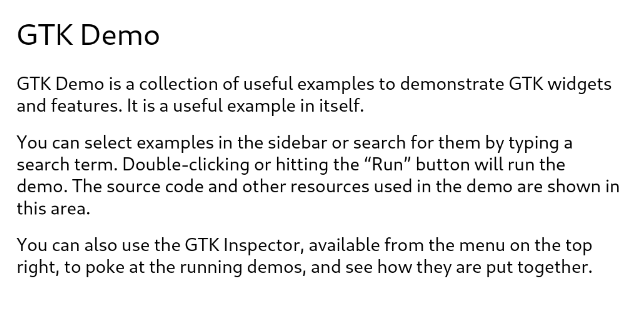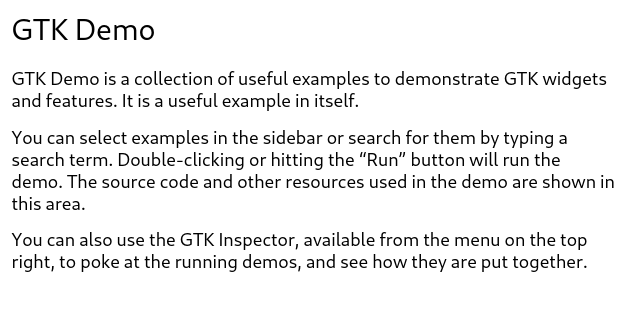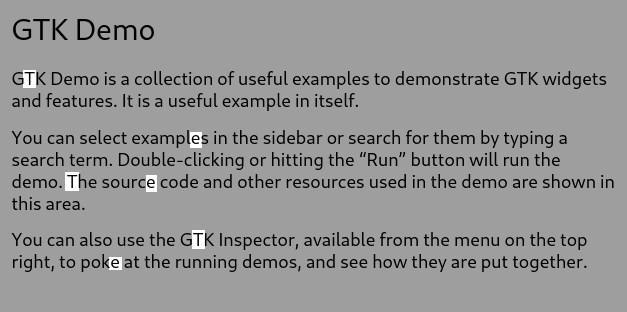GTK 4.14 brings various improvements on the accessibility front, especially for applications showing complex, formatted text; for WebKitGTK; and for notifications.
Accessible text interface
The accessibility rewrite for 4.0 provided an implementation for complex, selectable, and formatted text in widgets provided by GTK, like GtkTextView, but out of tree widgets would not be able to do the same, as the API was kept private while we discussed what ATs (assistive technologies) actually needed, and while we were looking at non-Linux implementations. For GTK 4.14 we finally have a public interface that out of tree widgets can implement to provide complex, formatted text to ATs: GtkAccessibleText.
GtkAccessibleText allows widgets to provide the text contents at given offsets; the text attributes applied to the contents; and to notify assistive technologies of changes in the text, caret position, or selection boundaries.
Text widgets implementing GtkAccessibleText should notify ATs in these cases:
-
- if the text widget has a caret cursor, it needs to call
gtk_accessible_text_update_caret_position()every time the caret moves - if the text widget has a selection, it needs to call
gtk_accessible_text_update_selection_bound()every time the selection changes - when the text changes, the widget needs to call
gtk_accessible_text_update_contents()with the description of what changed, and the boundaries of the change
- if the text widget has a caret cursor, it needs to call
Text attributes are mainly left to applications to implement—both in naming and serialization; GTK provides support for common text attributes already in use by various toolkits and assistive technologies, and they are available as constants under the GTK_ACCESSIBLE_ATTRIBUTE_* prefix in the API reference.
The GtkAccessibleText interface is a requirement for implementing the accessibility of virtual terminals; the most common GTK-based library for virtual terminals, VTE, has been ported to GTK4 thanks to the efforts of Christian Hergert and in GNOME 46 will support accessibility through the new GTK interface.
Bridging AT-SPI trees
There are cases when a library or an application implements its own accessible tree using AT-SPI, whether in the same process or out of process. One such library is WebKitGTK, which generates the accessible object tree from the web tree inside separate processes. These processes do not use GTK, so they cannot use the GtkAccessible API to describe their contents.
Thanks to the work of Georges Stavracas GTK now can bridge those accessibility object trees under the GTK widget’s own, allowing ATs to navigate into a web page using WebKit from the UI.
Currently, like the rest of the accessibility API in GTK, this is specific to the AT-SPI protocol on Linux, which means it requires libraries and applications that wish to take advantage of it to ensure that the API is available at compile time, through the use of a pkg-config file and a separate C header, similarly to how the printing API is exposed.
Notifications
Applications using in-app notifications that are decoupled by the current widget’s focus, like AdwToast in libadwaita, can now raise the notification message to ATs via the gtk_accessible_announce() method, thanks to Lukáš Tyrychtr, in a way that is respectful of the current ATs output.
Other improvements
GTK 4.12 ensured that the computed accessible labels and descriptions were up to date with the ARIA specification; GTK 4.14 iterates on those improvements, by removing special cases and duplicates.
Thanks to the work of Michael Weghorn from The Document Foundation, there are new roles for text-related accessible objects, like paragraphs and comments, as well as various fixes in the AT-SPI implementation of the accessibility API.
The accessibility support in GTK4 is incrementally improving with every cycle, thanks to the contributions of many people; ideally, these improvements should also lead to a better, more efficient protocol for toolkits and assistive technologies to share.
We are still exploring the possibility of adding backends for other accessibility platforms, like UIAutomation; and for other libraries, like AccessKit.







